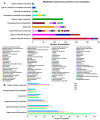Effect of Air Drying on the Metabolic Profile of Fresh Wild and Artificial Cordyceps sinensis
- PMID: 38201076
- PMCID: PMC10778509
- DOI: 10.3390/foods13010048
Effect of Air Drying on the Metabolic Profile of Fresh Wild and Artificial Cordyceps sinensis
Abstract
Fresh and dried Cordyceps sinensis are widely used by the public for medicinal and health purposes. However, the differences between them have not been examined. In this study, fresh wild and artificial C. sinensis (WFC and AFC) were dried to obtain dried wild and artificial C. sinensis (WDC and ADC). Non-targeted GC-MS was used to analyze the metabolic profile characteristics of the four groups of samples. The results showed that air drying significantly altered the composition and content of C. sinensis, mainly in the form of higher abundance of organic acids and derivatives and lower abundance of lipids and lipid-like molecules in fresh C. sinensis. Hierarchical cluster analysis (HCA) and quantitative analyses showed that air drying increased the abundance of Valine, Zinniol, Urocanate, Vulpinic acid, and Uridine 5'-diphosphate, and decreased Xanthotoxol, Vitexin-4-o-glucoside, Val-trp, and Wogonin. These differentially accumulated metabolites (DAMs) were also shown to be potential biomarkers for C. sinensis. KEGG enrichment analysis identified lysine biosynthesis as the most significantly enriched pathway. Annotation of these DAMs to lysine biosynthesis revealed that citrate cycle and pyruvate metabolism entered lysine biosynthesis via 2-oxohlutarate and Homocitrate, respectively, resulting in significant enrichment of L-saccharopine and L-lysine content was significantly higher. Alanine, aspartate, and Glutamate metabolism synthesized more L-aspartate to promote L-lysine synthesis. Thus, high levels of L-lysine result in lysine degradation and pymolysine, which are the most active metabolic pathways during the drying of fresh C. sinensis and indirectly lead to differences in metabolic profiles.
Keywords: Cordyceps sinensis; air drying; lysine biosynthesis; metabonomics.
Conflict of interest statement
The authors declare no conflicts of interest.
Figures







Similar articles
-
Effects of Drying Methods on Morphological Characteristics, Metabolite Content, and Antioxidant Capacity of Cordyceps sinensis.Foods. 2024 May 24;13(11):1639. doi: 10.3390/foods13111639. Foods. 2024. PMID: 38890867 Free PMC article.
-
Effects of Different Drying Methods on Amino Acid Metabolite Content and Quality of Ophiocordyceps sinensis by LC-MS/MS Combined with Multivariate Statistical Methods.Metabolites. 2024 Aug 18;14(8):459. doi: 10.3390/metabo14080459. Metabolites. 2024. PMID: 39195555 Free PMC article.
-
Evaluation of Lipid Changes During the Drying Process of Cordyceps sinensis by Ultra Performance Liquid Chromatography-Tandem Mass Spectrometry (UPLC-MS/MS)-Based Lipidomics Technique.J Fungi (Basel). 2024 Dec 11;10(12):855. doi: 10.3390/jof10120855. J Fungi (Basel). 2024. PMID: 39728352 Free PMC article.
-
Uncovering proteome variations and concomitant quality changes of different drying methods Cordyceps sinensis by 4D-DIA structural proteomics.Front Nutr. 2025 Feb 5;12:1463780. doi: 10.3389/fnut.2025.1463780. eCollection 2025. Front Nutr. 2025. PMID: 39973924 Free PMC article.
-
Can Cordyceps cicadae be used as an alternative to Cordyceps militaris and Cordyceps sinensis? - A review.J Ethnopharmacol. 2020 Jul 15;257:112879. doi: 10.1016/j.jep.2020.112879. Epub 2020 Apr 16. J Ethnopharmacol. 2020. PMID: 32305637 Review.
Cited by
-
Evaluation of Cordyceps sinensis Quality in 15 Production Areas Using Metabolomics and the Membership Function Method.J Fungi (Basel). 2024 May 16;10(5):356. doi: 10.3390/jof10050356. J Fungi (Basel). 2024. PMID: 38786711 Free PMC article.
-
Effects of Drying Methods on Morphological Characteristics, Metabolite Content, and Antioxidant Capacity of Cordyceps sinensis.Foods. 2024 May 24;13(11):1639. doi: 10.3390/foods13111639. Foods. 2024. PMID: 38890867 Free PMC article.
-
Effects of Different Drying Methods on Amino Acid Metabolite Content and Quality of Ophiocordyceps sinensis by LC-MS/MS Combined with Multivariate Statistical Methods.Metabolites. 2024 Aug 18;14(8):459. doi: 10.3390/metabo14080459. Metabolites. 2024. PMID: 39195555 Free PMC article.
-
Analysis of Metabolic Profiles and Antioxidant Activity of Chinese Cordyceps, Ophiocordyceps sinensis, and Paecilomyces hepiali Based on Untargeted Metabolomics.Biology (Basel). 2024 Aug 31;13(9):683. doi: 10.3390/biology13090683. Biology (Basel). 2024. PMID: 39336110 Free PMC article.
-
Comparative Metabolite Profiling Between Cordyceps sinensis and Other Cordyceps by Untargeted UHPLC-MS/MS.Biology (Basel). 2025 Jan 23;14(2):118. doi: 10.3390/biology14020118. Biology (Basel). 2025. PMID: 40001886 Free PMC article.
References
-
- Shalik R.S., Maan B.R., Zuzana M., Eryuan L. Habitat Ecology of Ophiocordyceps sinensis in Western Nepal. Mt. Res. Dev. 2017;37:216–223.
-
- Liu L., Guan L.L., Zhao H.X., Huang Y., Mou Q.Y., Liu K., Chen T.Y., Wang X.Y., Zhang Y., Wei B., et al. Modeling habitat suitability of Houttuynia cordata Thunb (Ceercao) using MaxEnt under climate change in China. Ecol. Inform. 2021;63:101324. doi: 10.1016/j.ecoinf.2021.101324. - DOI
-
- Zheng Y.L., Mei Q.X., Li W.J., Tang Z.F., Qian Z.M., Tao S.C., Dong P.P. Discussion on the medicinal history and modern administration method of Cordyceps sinensis. J. Chin. Med. Mater. 2017;40:2722–2725.
-
- Li G.R., Guo Y.F., Yu J.F., Liang G.H., Fang Q.M., Li W.J. Effects of different drying processes on quality of Chinese Cordyceps. J. Fungal Res. 2020;18:132–138.
Grants and funding
LinkOut - more resources
Full Text Sources
Miscellaneous

